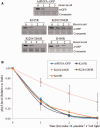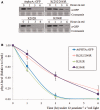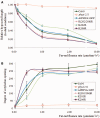Lysine 206 in Arabidopsis phytochrome A is the major site for ubiquitin-dependent protein degradation
- PMID: 26314334
- PMCID: PMC4892773
- DOI: 10.1093/jb/mvv085
Lysine 206 in Arabidopsis phytochrome A is the major site for ubiquitin-dependent protein degradation
Abstract
Phytochrome A (phyA) is a light labile phytochrome that mediates plant development under red/far-red light condition. Degradation of phyA is initiated by red light-induced phyA-ubiquitin conjugation through the 26S proteasome pathway. The N-terminal of phyA is known to be important in phyA degradation. To determine the specific lysine residues in the N-terminal domain of phyA involved in light-induced ubiquitination and protein degradation, we aligned the amino acid sequence of the N-terminal domain of Arabidopsis phyA with those of phyA from other plant species. Based on the alignment results, phytochrome over-expressing Arabidopsis plants were generated. In particular, wild-type and mutant (substitutions of conserved lysines by arginines) phytochromes fused with GFP were expressed in phyA(-)211 Arabidopsis plants. Degradation kinetics of over-expressed phyA proteins revealed that degradation of the K206R phyA mutant protein was delayed. Delayed phyA degradation of the K206R phyA mutant protein resulted in reduction of red-light-induced phyA-ubiquitin conjugation. Furthermore, seedlings expressing the K206R phyA mutant protein showed an enhanced phyA response under far-red light, resulting in inhibition of hypocotyl elongation as well as cotyledon opening. Together, these results suggest that lysine 206 is the main lysine for rapid ubiquitination and protein degradation of Arabidopsis phytochrome A.
Keywords: light-induced phyA degradation; phytochrome A; proteasome; ubiquitination.
© The Authors 2015. Published by Oxford University Press on behalf of the Japanese Biochemical Society. All rights reserved.
Figures






Similar articles
-
Subcellular sites of the signal transduction and degradation of phytochrome A.Plant Cell Physiol. 2010 Oct;51(10):1648-60. doi: 10.1093/pcp/pcq121. Epub 2010 Aug 25. Plant Cell Physiol. 2010. PMID: 20739301
-
A rice phytochrome A in Arabidopsis: The Role of the N-terminus under red and far-red light.Mol Plant. 2008 Jan;1(1):84-102. doi: 10.1093/mp/ssm010. Epub 2007 Oct 31. Mol Plant. 2008. PMID: 20031917
-
Functional characterization of phytochrome autophosphorylation in plant light signaling.Plant Cell Physiol. 2010 Apr;51(4):596-609. doi: 10.1093/pcp/pcq025. Epub 2010 Mar 4. Plant Cell Physiol. 2010. PMID: 20203237
-
Regulation of Plant Photoresponses by Protein Kinase Activity of Phytochrome A.Int J Mol Sci. 2023 Jan 20;24(3):2110. doi: 10.3390/ijms24032110. Int J Mol Sci. 2023. PMID: 36768431 Free PMC article. Review.
-
Phytochrome A-specific signaling in Arabidopsis thaliana.Plant Signal Behav. 2011 Nov;6(11):1714-9. doi: 10.4161/psb.6.11.17509. Epub 2011 Nov 1. Plant Signal Behav. 2011. PMID: 22067110 Free PMC article. Review.
Cited by
-
Phytochrome Signaling Is Mediated by PHYTOCHROME INTERACTING FACTOR in the Liverwort Marchantia polymorpha.Plant Cell. 2016 Jun;28(6):1406-21. doi: 10.1105/tpc.15.01063. Epub 2016 Jun 1. Plant Cell. 2016. PMID: 27252292 Free PMC article.
-
From photon to signal in phytochromes: similarities and differences between prokaryotic and plant phytochromes.J Plant Res. 2016 Mar;129(2):123-35. doi: 10.1007/s10265-016-0789-0. Epub 2016 Jan 27. J Plant Res. 2016. PMID: 26818948 Review.
-
Blue light receptor CRY1 regulates HSFA1d nuclear localization to promote plant thermotolerance.Cell Rep. 2023 Sep 26;42(9):113117. doi: 10.1016/j.celrep.2023.113117. Epub 2023 Sep 12. Cell Rep. 2023. PMID: 37703177 Free PMC article.
-
Rapid Transient Production of a Monoclonal Antibody Neutralizing the Porcine Epidemic Diarrhea Virus (PEDV) in Nicotiana benthamiana and Lactuca sativa.Planta Med. 2017 Dec;83(18):1412-1419. doi: 10.1055/s-0043-112344. Epub 2017 Jun 2. Planta Med. 2017. PMID: 28575911 Free PMC article.
-
Mass Spectrometric Analyses Reveal a Central Role for Ubiquitylation in Remodeling the Arabidopsis Proteome during Photomorphogenesis.Mol Plant. 2017 Jun 5;10(6):846-865. doi: 10.1016/j.molp.2017.04.008. Epub 2017 Apr 28. Mol Plant. 2017. PMID: 28461270 Free PMC article.
References
-
- Deng X.W., Quail P.H. (1999) Signalling in light-controlled development. Semin. Cell Dev. Biol. 10, 121–129 - PubMed
-
- Kami C., Lorrain S., Hornitschek P., Fankhauser C. (2010) Light-regulated plant growth and development. Curr. Top. Dev. Biol. 91, 29–66 - PubMed
-
- Neff M.M., Fankhauser C., Chory J. (2000) Light: an indicator of time and place. Genes Dev. 14, 257–271 - PubMed
-
- Franklin K.A., Larner V.S., Whitelam G.C. (2005) The signal transducing photoreceptors of plants. Int. J. Dev. Biol. 49, 653–664 - PubMed
-
- Demarsy E., Fankhauser C. (2009) Higher plants use LOV to perceive blue light. Curr. Opin. Plant Biol. 12, 69–74 - PubMed
Publication types
MeSH terms
Substances
LinkOut - more resources
Full Text Sources
Other Literature Sources
Molecular Biology Databases

